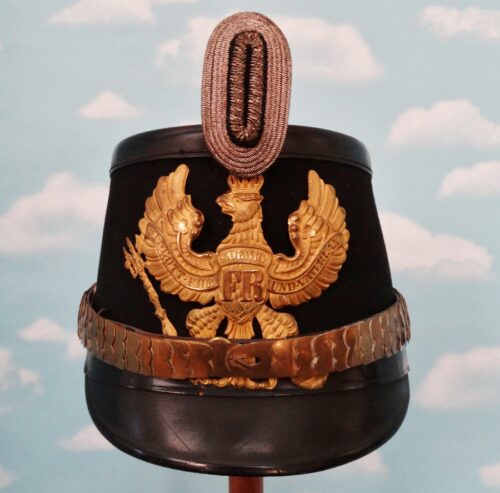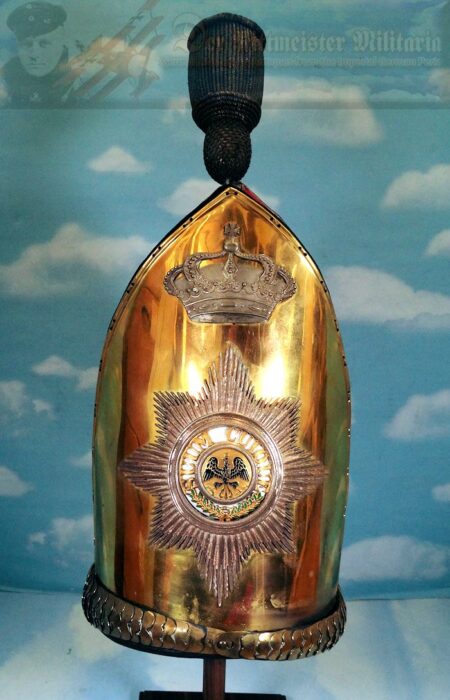Description
This is a very fine Ulanen-Regiment von Katzler (Schlesisches) Nr 2 officer’s tschapka. The regiment was founded in 1745 (during Frederick the Great’s reign), and garrisoned at Gleiwitz-Pleß. It was attached to the VI. Armeekorps. The helmet’s leather body is quite pleasing. It is very supple, smooth, and relatively problem-free. At first glance, it is the wappen that takes one’s attention. In terms of design (not counting their colors), three different Ulanen wappen-styles exist. First is that of the three Garde-Ulanen-Regiments. The two earliest Garde-Ulanen-Regiments were founded in 1819, while the third was created in 1860. Each one’s officers, NCO’s, and enlisted men sported the traditional Garde Stars on their wappens. Next come Ulanen-Regiment Nr’s 1, 2, and 3. These three regiments were among the first Prussian Ulanen-Regiments to be created: Nr’s 1 and 2 in 1745, and Nr 3 in 1809. Only Ulanen-Regiment Großherzog Friedrich von Baden (Rheinisches) Nr 7 was older, (having been founded in 1734). Ulanen-Regiment Nr’s 1 through 3 sported different center devices on their wappens. These boasted very elaborately formed royal cyphers featuring “WR” on them. (Later Ulanen-Regiments displayed the more conventional “FR” cypher in plain script, constituting the third wappen style). This wappen style was also used by Prussian line-infantry and artillery regiments. Ulanen-Regiment Nr’s 1-3’s wappens are very distinctive and very scarce. [I also suggest that you look closely at the crown’s top, which sports the open (voided) style indicative of an officer].
The helmet has all-gilt furniture, including the wappen, chin scales, and front visor trim. As we look further at its exterior, we see a single Reich’s kokarde on the helmet’s right side (from the wearer’s perspective). A Prussian officer’s feldzeichen (field badge) is displayed. Under the tschapka’s mortarboard is a red rabatt (a fabric covering the helmet section reaching from under the mortarboard to the leather body’s top). This is the confirmation that the helmet is from Ulanen-Regiment von Katzler (Schlesisches) Nr 2. Each of the three early regiments has a different-colored rabatt.
I was very excited when I was first offered this helmet. I hoped that it was for Ulanen-Regiment Kaiser Alexander III von Rußland (Westpreußisches) Nr 1. Why did I hope for this? It was THE regiment to which Manfred von Richthofen was attached before WW I, and during the war’s early months before he transferred to the Imperial German Air Service. He wore that regiment’s uniform until his death to honor his attachment to it. [This was very common during WW I, as men retained their former regiments’ uniforms and headdresses after they transferred to the Air Service]. Although it is a pity that the helmet is NOT from von Richthofen’s regiment, it is still very rare!
[I must mention two other details about the helmet’s exterior. The description’s headline mentions that the helmet comes complete with the cap lines and the parade bush. While this is true, I want to point our that these two items are NOT for an officer. A previous owner/collector added these NCO/enlisted men’s cap lines and parade bush. The buyer will have the option of displaying the tschapka as it is, or to make it totally correct, REMOVE the NCO/enlisted men’s cap lines and bush. I feel it is vital that all aspects of any item offered by Der Rittmeister Militaria be shared with our customers]!
Moving to the interior, we see that the tschapka does NOT have a silk liner. Instead, it has the NCO/enlisted men’s style liner, complete with all the tongues and its sizing thong. [A silk liner was an option for an officer’s helmet, not a requirement. Some officers felt more comfortable with this liner style. It is also very possible that the officer might have worn this helmet for less-formal occasions, and kept another helmet for dress functions. Many officers purchased extra helmets for this very reason. They did not want to dirty their best helmets, reserving them for supremely important occasions, NOT everyday usage]. No double holes are evident in the interior.
I have NO doubts that this is a correct officer’s tschapka. The NCO/enlisted men’s additions are merely a matter of individual taste. This is one of the rarest tschapkas I have ever offered, and I am very pleased to do so.















